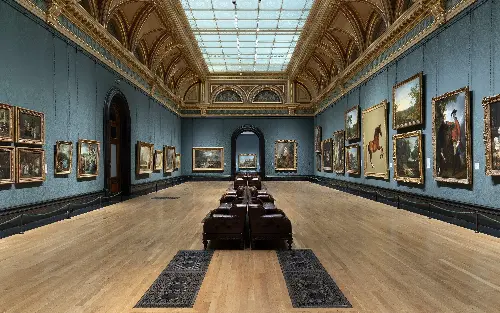
At last! After two years of disruption, with shuttered galleries and dispiriting queues, the National Gallery is reopening in its entirety – with a swanky new lobby – exactly 201 years after it was inaugurated in a nearby townhouse on Pall Mall. For many, including me, its paintings are cherished friends. So, it’s a relief to find more than a thousand of them looking this chipper – along with one or two new faces (including a slavering dragon like a berserk black cartoon lion, in a 16th-century altarpiece recently acquired for £16.4 million) – in a rare new redisplay of the collection, artlessly titled The Wonder of Art.
The idea to undertake a systematic rehang followed the decision to enhance the cramped entrance of the Sainsbury Wing, a postmodern addition to the gallery unveiled in 1991; since this risked imperilling the Early Renaissance pictures upstairs, they had to be decanted – providing an opportunity to rethink how everything should be presented.
Now, after passing through a curiously expansive, sofa-bedecked foyer (with a gigantic screen), reimagined by the German-born architect Annabelle Selldorf, who’s tucked the cloakroom away downstairs (on a landing above the basement’s untouched exhibition spaces), visitors head up, past Giorgio Locatelli’s new restaurant on the mezzanine, to be confronted – splat! – by Mud Sun, a 16ft-wide mural by the British artist Richard Long.
I love Long’s work, in other contexts, but what is this wilfully atavistic beige splodge – a flaring, seemingly squiggling disc of tidal silt from the River Avon, smeared onto a blackened wall above the lifts – doing at the threshold of the National Gallery? His pseudo-rock painting looks like a partially unravelled Woolmark logo; I dread to think how uninviting it will appear when the sky outside is grey. Why not show off something dramatic and colourful from the collection?
Thankfully, the rehung galleries dispel any grumbling. Responding to the architecture of the Sainsbury Wing, evoking a basilica, the curators recast the central spine of double-height spaces as a “nave”, adorned only with large religious pictures; secular favourites, such as The Battle of San Romano (c. 1438-40) by Paulo Uccello (newly conserved and reframed), or Sandro Botticelli’s Venus and Mars (c. 1485), are now in single-height rooms on either side, as if in a palazzo.
A massive 14th-century gilded altarpiece, made for a monastery in Florence, occupies the wing’s southern wall, solo. Another altarpiece, painted a century later by the brothers Antonio and Piero del Pollaiuolo, and depicting the martyrdom of Saint Sebastian, faces it to the north, almost 155 feet away – exemplifying the transition from “gold-ground” painting to something with a greater sense of plasticity and depth.
Between them, the gallery’s biggest painted Crucifix is suspended in mid-air, alluding to the way it was once displayed, on high, in an Italian church. This contextual nod is a motif of the redisplay, which, wherever possible, emphasises painting’s three-dimensionality – a welcome provocation in a digital age, when images are consumed as flat, backlit phantasms on smartphones.
Next door, in William Wilkins’s neoclassical 19th-century building, while a broad chronological sweep is maintained, art’s materiality is also stressed, with a smattering of thematic displays of pictures executed with fragile pastels and “plein air” oil sketches. Splendid rooms celebrate individual artists – Peter Paul Rubens, Rembrandt, Claude Monet (but not, surprisingly, Diego Velázquez) – including an instant-classic gallery with 10 (count ’em!) paintings by Titian. (Why hasn’t this been done before?) According to the National Gallery’s director, Gabriele Finaldi – who tells me, “I’m just desperate to open the doors!” – this “focus on strong personalities might be a sign of the times”. Art history for the age of the strongman, perhaps?
Other innovations include “transhistorical” displays inspired by JMW Turner’s stipulation that two paintings by him bequeathed to the National Gallery should always be shown beside a pair of landscapes by Claude, his 17th-century predecessor. Thus, “Le Chapeau de Paille”, by Rubens, appears next to Elisabeth Louise Vigée Le Brun’s Self Portrait in a Straw Hat (1782), which it inspired.
The latter commands a prominent spot in the Wilkins building – although The Mond Crucifixion (c. 1502-03), by Raphael, and George Stubbs’s Whistlejacket (c. 1762) still boss the longest sightline, connecting the Sainsbury Wing’s westernmost flank with a wall 595 feet away, at the gallery’s eastern limit. “Sometimes, you get it right the first time, don’t you?” says curator Christine Riding, who has led the redisplay.
Picking out Vigée Le Brun’s self-portrait alerts visitors to the only, as Riding puts it, “engineered” aspect of The Wonder of Art: the foregrounding of art by, depicting, or commissioned by women. Only one in around every 100 pictures in the National Gallery’s collection of approximately 2,400 works of art – some postcard-sized, others vast – is by a woman.
Four full-length female portraits appear together in room 11, including Henry VIII’s potential bride, Christina of Denmark, pale-faced and decked out in black, as depicted by Hans Holbein the Younger (whose other paintings, frustratingly, are scattered across the museum’s 66 rooms); elsewhere, a gallery dominated by Anthony van Dyck’s colossal equestrian portrait of Charles I turns out really to be about the taste of his queen, Henrietta Maria.
Yet, with calm, concise labels (which refrain from moralising, even when, if relevant, referring to ‘enslaved labour’), the redisplay doesn’t disparage long-dead artists, such as William Hogarth (take note, Tate!); rather, well thought through, and rarely forced, it’s attuned throughout to the pleasures of aesthetics. I left exhilarated, having traversed the entire tradition of Western European painting, from the end of the 13th century to the start of the 20th. And, to think, we get to take this voyage for free.
‘CC Land: The Wonder of Art’ opens at the National Gallery, London WC2 (nationalgallery.org.uk), on Sat May 10; The National Gallery: Paintings, People, Portraits (Taschen), marking its bicentenary, is out now
